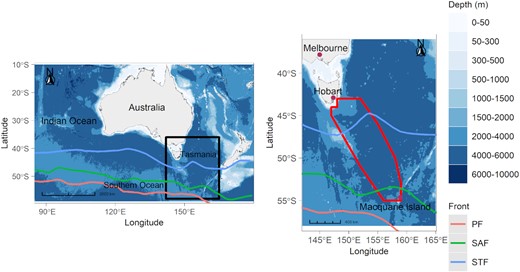
Long-term data analysis reveals species-specific responses to climate change between Black-browed Thalassarche melanophris and Light-mantled Phoebetria palpebrata albatrosses in the southwest Pacific Ocean according to new research.
The paper, “Multi-decadal changes in the at-sea distribution and abundance of black-browed and light-mantled sooty albatrosses in the southwest Pacific Ocean” by Milan Sojitra (Institute for Marine and Antarctic Studies, University of Tasmania, Australia) and colleagues, has been published open access in the journal ICES Journal of Marine Science.
 Map of the study area. Red polygon represents the extent of the surveyed area over the study period. PF (Antarctic Polar Front), SAF (Subantarctic Front), and STF (Subtropical Front). Fronts are far more dynamic that these lines indicate. Here, they are shown as reference (mean representative). (Bathymetry data from ggOceanMapsData, Amante and Aakins, 2009, and Front data from Orsi and Harris, 2019).
Map of the study area. Red polygon represents the extent of the surveyed area over the study period. PF (Antarctic Polar Front), SAF (Subantarctic Front), and STF (Subtropical Front). Fronts are far more dynamic that these lines indicate. Here, they are shown as reference (mean representative). (Bathymetry data from ggOceanMapsData, Amante and Aakins, 2009, and Front data from Orsi and Harris, 2019).
The paper’s abstract follows:
“Many long-term studies have reported changes in seabird abundance and distribution in response to climate change and various anthropogenic activities. However, a greater understanding of how species are responding to change over large spatial and temporal scales are required—particularly at high latitudes such as the Southern Ocean. We examined black-browed Thalassarche melanophris (BBAL) and light-mantled sooty Phoebetria palpebrata albatross (LMSA) observations spanning over 50 years. Both species have a wide-ranging distribution in a rapidly changing Southern Ocean. We used generalized additive models (GAMs) to investigate environmental drivers of their abundance and occurrence. Our results show that climate indices, sea surface temperature and sea surface height are the main drivers influencing the distribution and abundance of both species. The abundance of BBAL southeast of Australia was observed to be decreased substantially whereas no significant change was observed in the abundance of LMSA. Both species demonstrated contrasting distributions along their latitudinal gradient with BBAL showing early stages of a southward range shift. Our analyses suggest that responses to climate change are species-specific. These rare, long-term data have provided an understanding of species’ responses to past changes in the marine environment and can provide critical information for future conservation and management.”
Reference:
Milan Sojitra, Eric J Woehler, Mary-Anne Lea, Simon Wotherspoon, Multi-decadal changes in the at-sea distribution and abundance of black-browed and light-mantled sooty albatrosses in the southwest Pacific Ocean, ICES Journal of Marine Science, Volume 79, Issue 10, December 2022, Pages 2630–2642, https://doi.org/10.1093/icesjms/fsac197
19 Decemebr 2022

 Español
Español  English
English  Français
Français